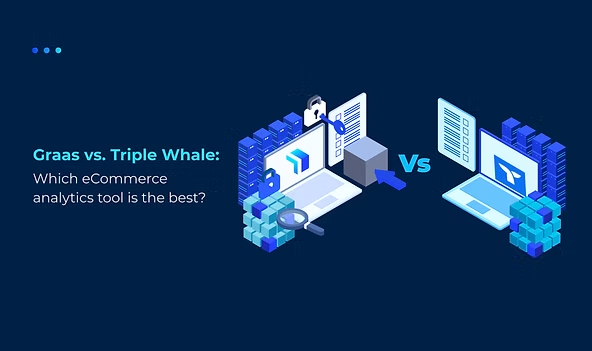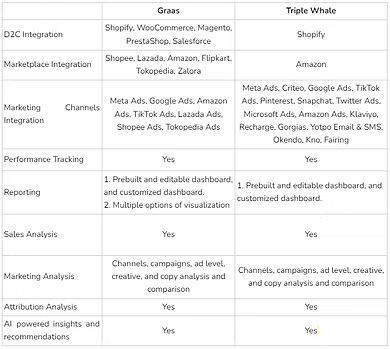
Today data has become critical. With analytics forming the backbone for optimizinge operations, delivering personalized experiences to customers and making real time decisions, it is essential that you get your hands on the right eCommerce analytics tool - one that can support your business across sales, marketing and inventory.
If you are looking for an all in tool eCommerce analytics tool to fuel your eCommerce business growth, you are in the right place. In this article we will dive deep into Graas and Triple Whale as analytics tools to support your eCommerce business.
Let’s discuss!
Graas and Triple Whale offer data analytics solutions for eCommerce businesses. Both offer the following:
So what makes them different? Let's break them down one by one.
eCommerce analytics can bridge the gap between marketing efforts and their impact on sales and revenue. This requires seamless integration with multiple platforms and data sources.
Graas and Triple Whale have the capabilities to access data from various eCommerce platforms. Make sure the tool that you choose supports all channel integrations for data extraction and synchronization.

eCommerce businesses should be aware of the range of data integrations available with Triple Whale and Graas. When it comes to storefront, Triple Whale covers Shopify and Amazon. Graas, on the other hand, integrates with an extensive list of D2C and Marketplace platforms as seen in the table above. If you are running your eCommerce business in marketplaces outside Amazon, Triple Whale might not be the right eCommerce analytics tool for you.
Triple Pixel is a script that can be installed on the storefront pages’ HTML to track visitors. For marketing channels, Triple Whale UTMs have to be added.
If you are running an eCommerce business in multiple sales channels from D2C to marketplaces, Graas has several options for you to connect your sales and marketing channels.
For D2C, the Graas Pixel allows businesses using WooCommerce, Magento, PrestaShop, and Salesforce to streamline their data into the Graas’ analytics platform.
All you need to do is install Graas Pixel through Google Tag Manager (GTM) to these channels. Meanwhile for eCommerce businesses who use Shopify, API integration is supported in the system. In addition to this, Graas provides Chrome Extension to extract metrics that are not available via API. Once the Chrome Extension is installed, it automates the process of downloading reports from marketplaces such as Lazada, Shopee, Amazon, and Flipkart.
Triple Whale has Summary and Graas has Workspace. Both provide all important metrics performance just in one platform.
Under Triple Whale’s Summary you can get:
Graas’ Workspace offers pre-built dashboards that are editable as well as custom dashboards.
Again, these two dashboards are customizable and editable. You can add a new card with Chart Builder with a wide range of sales and marketing metrics. Chart Builder will also give you options of how your data want to be displayed. Starting from MultiAxis Line, Overlap, Funnel, and more.
The right eCommerce analytics tool should not only stop by seamless data integrations and data visualizations. It should also support eCommerce businesses’ stakeholders to do analysis.
Triple Whale offers Pixel, Cohorts, and Product Analytics.
Graas offers Business Deep Dive, Marketing Deep Dive, Root Cause Analysis, and Attribution.
Revenue = Traffic × Conversion Rate × AOV
This equation provides a simple approach to analyze and optimize an eCommerce business's performance. With the Business Deep Dive, you can compare various channels, stores, and products across more than 100+ metrics.
These analytical tools provided by both Graas and Triple Whale offer real-time data analytics for eCommerce businesses. Any stakeholder needs to consider how deep an eCommerce analytics tool can support you in elevating marketing and sales effort.
Besides visualizing and analyzing your sales, marketing, and product performances, a tool that can generate insights and recommendations based on the data will be a big help for you to make swift decisions especially in critical situations.
Overall, choose the right analytics tool that is suitable and compatible for your eCommerce businesses.

The right eCommerce analytics tool will not only get your eCommerce data seamlessly integrated, but also provide real-time access to insights and strategic recommendations to improve your eCommerce business’ performance.
Sign up today to leverage Graas’ advanced analytics to optimize and reach new heights for your business!
Today data has become critical. With analytics forming the backbone for optimizinge operations, delivering personalized experiences to customers and making real time decisions, it is essential that you get your hands on the right eCommerce analytics tool - one that can support your business across sales, marketing and inventory.
If you are looking for an all in tool eCommerce analytics tool to fuel your eCommerce business growth, you are in the right place. In this article we will dive deep into Graas and Triple Whale as analytics tools to support your eCommerce business.
Let’s discuss!
Graas and Triple Whale offer data analytics solutions for eCommerce businesses. Both offer the following:
So what makes them different? Let's break them down one by one.
eCommerce analytics can bridge the gap between marketing efforts and their impact on sales and revenue. This requires seamless integration with multiple platforms and data sources.
Graas and Triple Whale have the capabilities to access data from various eCommerce platforms. Make sure the tool that you choose supports all channel integrations for data extraction and synchronization.

eCommerce businesses should be aware of the range of data integrations available with Triple Whale and Graas. When it comes to storefront, Triple Whale covers Shopify and Amazon. Graas, on the other hand, integrates with an extensive list of D2C and Marketplace platforms as seen in the table above. If you are running your eCommerce business in marketplaces outside Amazon, Triple Whale might not be the right eCommerce analytics tool for you.
Triple Pixel is a script that can be installed on the storefront pages’ HTML to track visitors. For marketing channels, Triple Whale UTMs have to be added.
If you are running an eCommerce business in multiple sales channels from D2C to marketplaces, Graas has several options for you to connect your sales and marketing channels.
For D2C, the Graas Pixel allows businesses using WooCommerce, Magento, PrestaShop, and Salesforce to streamline their data into the Graas’ analytics platform.
All you need to do is install Graas Pixel through Google Tag Manager (GTM) to these channels. Meanwhile for eCommerce businesses who use Shopify, API integration is supported in the system. In addition to this, Graas provides Chrome Extension to extract metrics that are not available via API. Once the Chrome Extension is installed, it automates the process of downloading reports from marketplaces such as Lazada, Shopee, Amazon, and Flipkart.
Triple Whale has Summary and Graas has Workspace. Both provide all important metrics performance just in one platform.
Under Triple Whale’s Summary you can get:
Graas’ Workspace offers pre-built dashboards that are editable as well as custom dashboards.
Again, these two dashboards are customizable and editable. You can add a new card with Chart Builder with a wide range of sales and marketing metrics. Chart Builder will also give you options of how your data want to be displayed. Starting from MultiAxis Line, Overlap, Funnel, and more.
The right eCommerce analytics tool should not only stop by seamless data integrations and data visualizations. It should also support eCommerce businesses’ stakeholders to do analysis.
Triple Whale offers Pixel, Cohorts, and Product Analytics.
Graas offers Business Deep Dive, Marketing Deep Dive, Root Cause Analysis, and Attribution.
Revenue = Traffic × Conversion Rate × AOV
This equation provides a simple approach to analyze and optimize an eCommerce business's performance. With the Business Deep Dive, you can compare various channels, stores, and products across more than 100+ metrics.
These analytical tools provided by both Graas and Triple Whale offer real-time data analytics for eCommerce businesses. Any stakeholder needs to consider how deep an eCommerce analytics tool can support you in elevating marketing and sales effort.
Besides visualizing and analyzing your sales, marketing, and product performances, a tool that can generate insights and recommendations based on the data will be a big help for you to make swift decisions especially in critical situations.
Overall, choose the right analytics tool that is suitable and compatible for your eCommerce businesses.

The right eCommerce analytics tool will not only get your eCommerce data seamlessly integrated, but also provide real-time access to insights and strategic recommendations to improve your eCommerce business’ performance.
Sign up today to leverage Graas’ advanced analytics to optimize and reach new heights for your business!